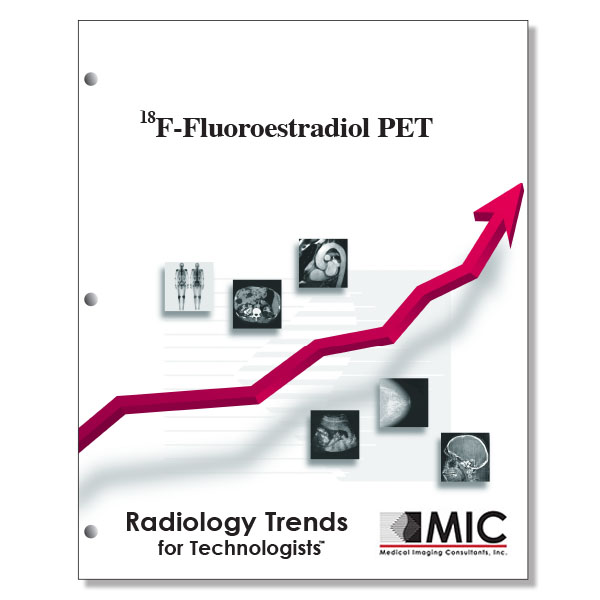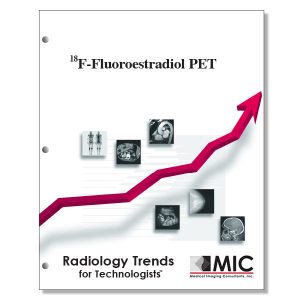

18F-Fluoroestradiol PET
The biology and pharmacokinetics of 18F-fluoroestradiol are reviewed and the potential clinical applications and possible future uses of 18F-fluoroestradiol PET are discussed.
Course ID: Q00496 Category: Radiology Trends for Technologists Modalities: CT, Mammography, Nuclear Medicine, PET, Radiation Therapy1.75 |
Satisfaction Guarantee |
$24.00
- Targeted CE
- Outline
- Objectives
This course has been approved for 1.75 Category A credits.
No discipline-specific Targeted CE credit is currently offered by this course.
Outline
- Introduction
- 18F-FES Structure, Synthesis, Pharmacokinetics, and Safety
- Correlation of 18F-FES Uptake and Tumor ER Expression
- Baseline 18F-FES Uptake as a Predictor of Response to Endocrine Safety
- Ability of 18F-FES PET to Assess Whole-body Tumor Burden and Heterogeneity of Disease
- Utility of 18F-FES PET in Assessing In Vivo Pharmacodynamics
- Non-Breast Cancer Uses of 18F-FES
- Uterine Endometrium and Myometrium
- Epithelial Ovarian Cancer
- Other Uses
- Potential Clinical Uses
- Breast Cancer Detection and Staging
- Predicting Response to Endocrine Therapy
- Barriers to Widespread Clinical Use of 18F-FES PET
- Conclusion
Objectives
Upon completion of this course, students will:
- know the traditional assessment method for ER expression in breast cancer
- understand the importance of determining a breast tumor’s ER status
- know when 18F-FDG PET/CT is recommended for breast cancer assessment
- know the potential use cases for 18F-FES PET when used in conjunction with 18F-FDG PET
- be familiar with the elements that were part of early efforts to develop an ER-targeting radiotracer
- know the properties that make 18F an optimal PET imaging radiotracer
- identify a major issue with 18F-moxestrol in comparison to 18F-FES
- be familiar with the uptake process of 18F-FES
- know the critical organ for 18F-FES dose
- be familiar with the early studies demonstrating associations between 18F-FES uptake and various lab results
- be familiar with the methods of the Peterson et al. studies and their findings
- know the factors that can affect tumor 18F-FES uptake, as well as those shown to not have an effect on its uptake
- know the suggested specific activity of 18F-FES for patient injection
- understand the advantages of endocrine therapy for patients with ER-positive breast cancer
- be familiar with 18F-FES PET study findings for use as a predictor of response to endocrine therapy
- understand the role of 18F-FES PET in the assessment of the theory that long-term antiestrogen therapy may induce estrogen hypersensitivity
- be familiar with the use of 18F-FDG PET for predicting endocrine therapy response
- know the advantages of both serial 18F-FDG and pre-therapy 18F-FES to predict endocrine responsiveness
- know the value and meaning of determining discordant 18F-FDG and 18F-FES uptake upon PET imaging
- know why determining discordant in vitro ER expression and 18F-FES uptake is important
- understand the meaning behind a finding for a patient who has both 18F-FES positive and negative lesions
- understand why 18F-FES PET could represent an important adjunct for ER expression monitoring at time of disease progression or throughout a course of treatment
- be familiar with the various breast cancer treatment methods and how they affect ER and in turn affect 18F-FES uptake
- be familiar with the findings from a study of fulvestrant dose levels in murine xenographs that suggest that changes in ER availability occur before detectable changes in tumor metabolism and growth
- be familiar with the uptake patterns of 18F-FES and 18F-FDG in uterine endometrial hyperplasia, as well as in both low-grade and high-grade endometrial cancers
- know the utility for 18F-FES PET in the differentiation of benign uterine leiomyomas from malignant uterine sarcomas
- be familiar with the various potential roles for 18F-FES PET imaging for epithelial ovarian cancers
- know the reasons why 18F-FES PET is unlikely to supersede 18F-FDG PET as the primary PET tool for breast cancer staging
- understand how clinicians currently often base their choice of endocrine therapy and how 18F-FES PET can better inform their therapeutic approach
- know the barriers to more widespread use of 18F-FES PET
